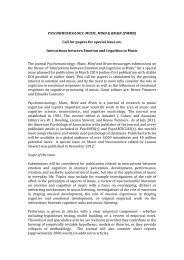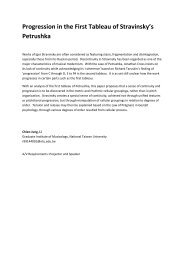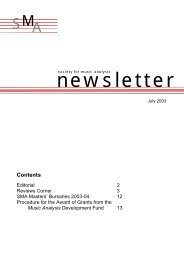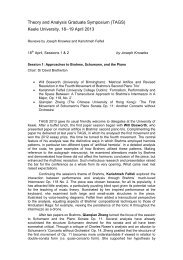Newsletter No. 31 (January 2009) (PDF) - Society for Music Analysis
Newsletter No. 31 (January 2009) (PDF) - Society for Music Analysis
Newsletter No. 31 (January 2009) (PDF) - Society for Music Analysis
Create successful ePaper yourself
Turn your PDF publications into a flip-book with our unique Google optimized e-Paper software.
heterogeneous and (arguably) moresystematic procedures. Neither had muchto say about the other‟s music, but it mightbe surmised that Messiaen‟s <strong>for</strong>ms andstylistic qualities were too reminiscent ofIvesian centrifugalism <strong>for</strong> Carter to findthem acceptable as that „emancipateddiscourse‟ to which he himself aspired. 3 AsCarter might have put it, it would havedone Messiaen good to knuckle down toserious, disciplined training under NadiaBoulanger – and no wonder „Madame‟always had doubts about Messiaen‟smusic. 4 Looking at Carter, Messiaen mighthave felt that (as with several of his ownmost prominent pupils) „emancipation‟ hadgone too far, and deplored the music‟ssecular ethos. Yet both composersattached immense importance toconveying a celebratory, even joyful spirit,placing the inevitable turbulence andfragmentation of musical modernism inunusually positive perspectives.Such generalities suggest a wealth ofpossibilities <strong>for</strong> analysts undertaking closereadings of their most characteristiccompositions. Nevertheless, as thecentenary month approached one wasmost conscious of disparity in that (froman admittedly unscientific impression)Messiaen seems to have had the lion‟sshare of attention, both in the concert halland in substantial publications,biographical and critical. Doubtless thathas much to do with the fact that, since1992, Messiaen‟s career has been„finished business‟, and it has beenpossible to work on those multifariousmaterials that survive under thestewardship of Yvonne Loriod-Messiaen,as Peter Hill and Nigel Simeone haveshown. In addition, the publication of the7-volume Traité de rythme, de couleur etd’ornithologie (1994-2002) hasreinvigorated technical studies of thecomposer‟s understanding of modality andmany other raw materials. On a muchsmaller scale, the appearance of Carter‟sHarmony Book in 2002 underlined the kindof details about his technical thinking thathad long been known from examples likethe charts <strong>for</strong> the Concerto <strong>for</strong> Orchestra.Yet in 2008 the emphasis with Carter hasbeen more on celebrating the remarkablecontinuation of his creative work right up tothe present: commemorative publications,with the exception of a slender collectionof essays from Pendragon Press and a„centennial portrait‟ from the SacherStiftung in Basel, where his sketches andmanuscripts are housed, have been thinon the ground. 5In this context, it was particularly gratifying<strong>for</strong> CarMAC 2008 to find itself – at least <strong>for</strong>its first eight hours – exploring Carterrather than Messiaen, with five papers thatfell into two broad categories: closereadings of small-scale works, andbroader explorations of the character andmeaning of larger and more representativecompositions. In the first category, MarionGuck‟s discussion of „qualities of action ...in Au quai‟ focused on the 56-measureduo <strong>for</strong> viola and bassoon (2002) with thejokey Schoenbergian title, a title given newpertinence in Carter‟s miniscule salute toOliver Knussen. Guck introduced aphenomenological, „receptional‟ analysisthat moved between the kind of qualitiesrepresented by „limping‟, „singing „and„dwindling‟ and small-scale „constructional‟features relating mainly to one of Carter‟sfavoured pitch-class collections, the alltrichord(or all-triad) hexachord. Guck‟sdiscourse played usefully with thingsheard – or rather, with her recollection andsubsequent thoughts about things thatseemed to have been heard – the realtimeof the twenty-or-so minutes talk inproductive tension with the real time of aless-than-three-minute composition. Theconference‟s other close Carter readingwas an even more dramatic indication ofhow a sustained verbal narrative – thisone nearer to thirty minutes – could<strong>for</strong>cefully spread-eagle yet usefullyilluminate a six-minute flute monody.Joshua Mailman‟s „An imagined drama ofcompetitive opposition in Carter‟s Scrivo invento‟ complemented Guck‟s specifics ofaction as analogies <strong>for</strong> modes of physicalmotion (limping), spatial volume(dwindling) and musical activity (singing)with a fundamental binary strategydetermining <strong>for</strong>m, content and aestheticorientation – the latter the Heraclitean viewof music as „a flux of opposing <strong>for</strong>cesseeking and resisting unity‟, which3Elliott Carter, Collected Essays and Lectures,1987–1995, ed. Jonathan W. Bernard (Rochester,NY: University of Rochester Press, 1997), e.g.10.4 Peter Hill and Nigel Simeone, Messiaen (NewHaven and London: Yale University Press, 2005), <strong>31</strong>.5 A volume of Carter Studies is in preparation <strong>for</strong>publication by Cambridge University Press, probablyin 2010.SMA newsletter 6







